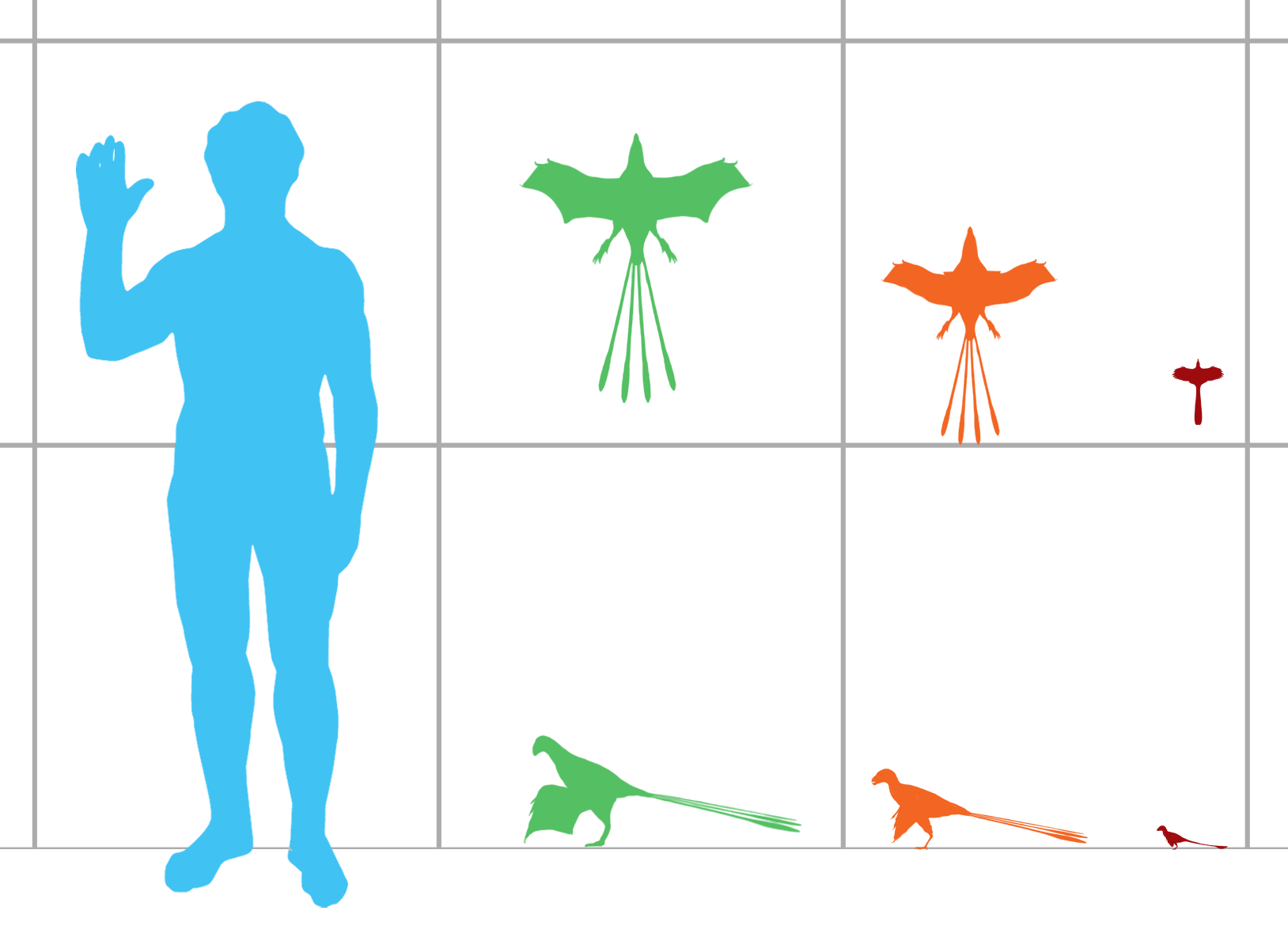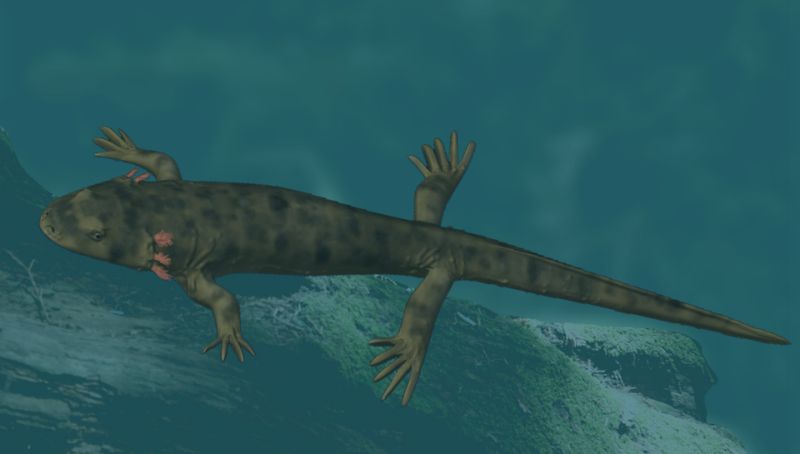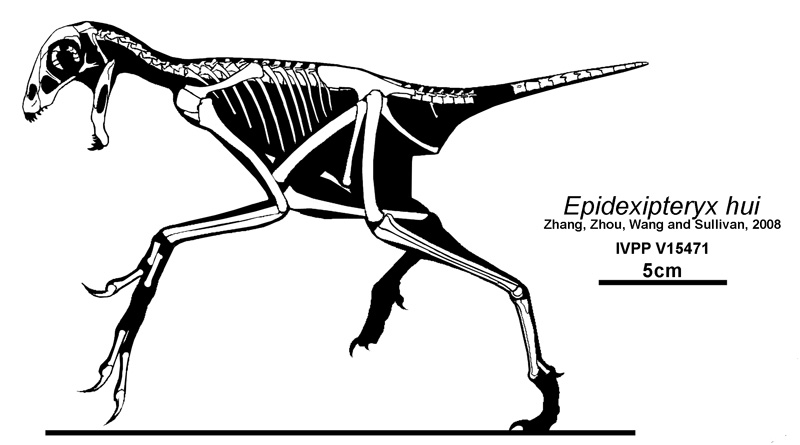|
Scansoriopterygid
Scansoriopterygidae (meaning "climbing wings") is an extinct family of climbing and gliding maniraptoran dinosaurs. Scansoriopterygids are known from five well-preserved fossils, representing four species, unearthed in the Tiaojishan Formation fossil beds (dating to the mid-late Jurassic Period) of Liaoning and Hebei, China. '' Scansoriopteryx heilmanni'' (and its likely synonym ''Epidendrosaurus ninchengensis'') was the first non-avian dinosaur found that had clear adaptations to an arboreal or semi-arboreal lifestyle–it is likely that they spent much of their time in trees. Both specimens showed features indicating they were juveniles, which made it difficult to determine their exact relationship to other non-avian dinosaurs and birds. It was not until the description of '' Epidexipteryx hui'' in 2008 that an adult specimen was known. In 2015, the discovery of another, larger adult specimen belonging to the species '' Yi qi'' showed that scansoriopterygids were not only c ... [...More Info...] [...Related Items...] OR: [Wikipedia] [Google] [Baidu] |
Yi (dinosaur)
''Yi'' is a genus of scansoriopterygid dinosaurs from the Late Jurassic of China. Its only species, ''Yi qi'' (Mandarin pronunciation: ; from and ), is known from a single fossil specimen of an adult individual found in Middle or Late Jurassic Tiaojishan Formation of Hebei, China, approximately 159 million years ago. It was a small, possibly tree-dwelling (arboreal) animal. Like other scansoriopterygids, ''Yi'' possessed an unusual, elongated third finger, that appears to have helped to support a membranous gliding plane made of skin. The planes of ''Yi qi'' were also supported by a long, bony strut attached to the wrist. This modified wrist bone and membrane-based plane is unique among all known dinosaurs, and might have resulted in wings similar in appearance to those of bats. Discovery and naming The first and only known fossil specimen of ''Yi qi'' was found by a farmer, Wang Jianrong, in a quarry near Mutoudeng Village ( Qinglong County, Hebei). Wang sold the fossil to the ... [...More Info...] [...Related Items...] OR: [Wikipedia] [Google] [Baidu] |
Ambopteryx
''Ambopteryx'' (meaning "both wing") is a genus of scansoriopterygid dinosaur from the Oxfordian stage of the Late Jurassic of China. It is the second dinosaur to be found with both feathers and bat-like membranous wings. ''Yi'', the first such dinosaur, was described in 2015 and is the sister taxon to ''Ambopteryx''. The holotype specimen is thought to be a sub-adult or adult. The specimen is estimated to have had a body length of and a weight of . The genus includes one species, ''Ambopteryx longibrachium''. Etymology The generic name ''Ambopteryx'' is derived from the Latin word ''ambo'' meaning "both" and Ancient Greek word ''πτέρυξ'' (''pteryx'') meaning "wing", a reference to the animal's membranous wings and bird-like body plan. The specific name ''longibrachium'' is derived from the Latin words ''longus'' meaning "long" and ''brachium'' meaning "upper arm". Holotype The holotype specimen, IVPP V24192, is an articulated and nearly complete skeleton with associ ... [...More Info...] [...Related Items...] OR: [Wikipedia] [Google] [Baidu] |
Tiaojishan Formation
The Tiaojishan Formation is a geological formation in Hebei and Liaoning, People's Republic of China, dating to the middle-late Jurassic period (Bathonian- Oxfordian stages). It is known for its exceptionally preserved fossils, including those of plants, insects and vertebrates. It is made up mainly of pyroclastic rock interspersed with basic volcanic and sedimentary rocks. Previously, the Tiaojishan Formation was grouped together with the underlying Haifanggou Formation (also known as the Jiulongshan Formation) as a single "Lanqi Formation." The Tiaojishan Formation forms a key part of the Yanliao Biota assemblage, alongside the Haifanggou Formation. Age Using Argon–argon dating, Wang and colleagues in 2005 dated part of the Tiaojishan Formation to about 160 million years ago, the beginning of the Oxfordian stage, the first stage of the Upper Jurassic epoch. In 2006, a study by Liu and colleagues used U-Pb zircon dating to conclude that the Tiaojishan Formation correlates wi ... [...More Info...] [...Related Items...] OR: [Wikipedia] [Google] [Baidu] |
Epidexipteryx
''Epidexipteryx'' is a genus of small paravian dinosaurs, known from one fossil specimen in the collection of the Institute of Vertebrate Paleontology and Paleoanthropology in Beijing. ''Epidexipteryx'' represents the earliest known example of ornamental feathers in the fossil record. Discovery The type specimen is catalog number IVPP V 15471. The specific name, ''Epidexipteryx hui'' ("Hu's display feather"), and its Chinese name ''Hushi Yaolong'' ("Hu Yaoming's dragon") were coined in memory of paleomammologist Hu Yaoming. Due to a pre-publication error,Dr. Thomas Holtz, Jr. "The mistaken scansoripterygid". Message to the Dinosaur Mailing List (October 1, 2008) a manuscript of the ''Epidexipteryx hui'' description first appeared on a preprint Web portal in late September 2008. The paper was officially published in the October 23, 2008 issue of the journal ''Nature''. Description ''E. hui'' is known from a well-preserved partial skeleton that includes four long feathers o ... [...More Info...] [...Related Items...] OR: [Wikipedia] [Google] [Baidu] |
Epidexipteryx Hui
''Epidexipteryx'' is a genus of small paravian dinosaurs, known from one fossil specimen in the collection of the Institute of Vertebrate Paleontology and Paleoanthropology in Beijing. ''Epidexipteryx'' represents the earliest known example of ornamental feathers in the fossil record. Discovery The type specimen is catalog number IVPP V 15471. The specific name, ''Epidexipteryx hui'' ("Hu's display feather"), and its Chinese name ''Hushi Yaolong'' ("Hu Yaoming's dragon") were coined in memory of paleomammologist Hu Yaoming. Due to a pre-publication error,Dr. Thomas Holtz, Jr. "The mistaken scansoripterygid". Message to the Dinosaur Mailing List (October 1, 2008) a manuscript of the ''Epidexipteryx hui'' description first appeared on a preprint Web portal in late September 2008. The paper was officially published in the October 23, 2008 issue of the journal ''Nature''. Description ''E. hui'' is known from a well-preserved partial skeleton that includes four long feathers o ... [...More Info...] [...Related Items...] OR: [Wikipedia] [Google] [Baidu] |
Scansoriopteryx
''Scansoriopteryx'' ("climbing wing") is a genus of maniraptoran dinosaur. Described from only a single juvenile fossil specimen found in Liaoning, China, ''Scansoriopteryx'' is a sparrow-sized animal that shows adaptations in the foot indicating an arboreal (tree-dwelling) lifestyle. It possessed an unusual, elongated third finger which may have supported a membranous wing, much like the related '' Yi qi''. The type specimen of ''Scansoriopteryx'' also contains the fossilized impression of feathers.Czerkas, S.A., and Yuan, C. (2002). "An arboreal maniraptoran from northeast China." Pp. 63-95 in Czerkas, S.J. (Ed.), ''Feathered Dinosaurs and the Origin of Flight.'' The Dinosaur Museum Journal 1. The Dinosaur Museum, Blanding, U.S.APDF abridged version/ref> Most researchers regard this genus as a synonym of ''Epidendrosaurus'', with some preferring to treat ''Scansoriopteryx'' as the junior synonym,Padian, Kevin. (2001) "Basal Avialae" in "The Dinosauria" in "The Dinosauria: Secon ... [...More Info...] [...Related Items...] OR: [Wikipedia] [Google] [Baidu] |
Scansoriopteryx
''Scansoriopteryx'' ("climbing wing") is a genus of maniraptoran dinosaur. Described from only a single juvenile fossil specimen found in Liaoning, China, ''Scansoriopteryx'' is a sparrow-sized animal that shows adaptations in the foot indicating an arboreal (tree-dwelling) lifestyle. It possessed an unusual, elongated third finger which may have supported a membranous wing, much like the related '' Yi qi''. The type specimen of ''Scansoriopteryx'' also contains the fossilized impression of feathers.Czerkas, S.A., and Yuan, C. (2002). "An arboreal maniraptoran from northeast China." Pp. 63-95 in Czerkas, S.J. (Ed.), ''Feathered Dinosaurs and the Origin of Flight.'' The Dinosaur Museum Journal 1. The Dinosaur Museum, Blanding, U.S.APDF abridged version/ref> Most researchers regard this genus as a synonym of ''Epidendrosaurus'', with some preferring to treat ''Scansoriopteryx'' as the junior synonym,Padian, Kevin. (2001) "Basal Avialae" in "The Dinosauria" in "The Dinosauria: Secon ... [...More Info...] [...Related Items...] OR: [Wikipedia] [Google] [Baidu] |
Jurassic Period
The Jurassic ( ) is a geologic period and stratigraphic system that spanned from the end of the Triassic Period million years ago (Mya) to the beginning of the Cretaceous Period, approximately Mya. The Jurassic constitutes the middle period of the Mesozoic Era and is named after the Jura Mountains, where limestone strata from the period were first identified. The start of the Jurassic was marked by the major Triassic–Jurassic extinction event, associated with the eruption of the Central Atlantic Magmatic Province. The beginning of the Toarcian Stage started around 183 million years ago and is marked by an extinction event associated with widespread oceanic anoxia, ocean acidification, and elevated temperatures likely caused by the eruption of the Karoo-Ferrar large igneous provinces. The end of the Jurassic, however, has no clear boundary with the Cretaceous and is the only boundary between geological periods to remain formally undefined. By the beginning of the Jurassic, t ... [...More Info...] [...Related Items...] OR: [Wikipedia] [Google] [Baidu] |
Epidendrosaurus
''Scansoriopteryx'' ("climbing wing") is a genus of maniraptoran dinosaur. Described from only a single juvenile fossil specimen found in Liaoning, China, ''Scansoriopteryx'' is a sparrow-sized animal that shows adaptations in the foot indicating an arboreal (tree-dwelling) lifestyle. It possessed an unusual, elongated third finger which may have supported a membranous wing, much like the related '' Yi qi''. The type specimen of ''Scansoriopteryx'' also contains the fossilized impression of feathers.Czerkas, S.A., and Yuan, C. (2002). "An arboreal maniraptoran from northeast China." Pp. 63-95 in Czerkas, S.J. (Ed.), ''Feathered Dinosaurs and the Origin of Flight.'' The Dinosaur Museum Journal 1. The Dinosaur Museum, Blanding, U.S.APDF abridged version/ref> Most researchers regard this genus as a synonym of ''Epidendrosaurus'', with some preferring to treat ''Scansoriopteryx'' as the junior synonym,Padian, Kevin. (2001) "Basal Avialae" in "The Dinosauria" in "The Dinosauria: Secon ... [...More Info...] [...Related Items...] OR: [Wikipedia] [Google] [Baidu] |
Scansoriopteryx Heilmanni
''Scansoriopteryx'' ("climbing wing") is a genus of maniraptoran dinosaur. Described from only a single juvenile fossil specimen found in Liaoning, China, ''Scansoriopteryx'' is a sparrow-sized animal that shows adaptations in the foot indicating an arboreal (tree-dwelling) lifestyle. It possessed an unusual, elongated third finger which may have supported a membranous wing, much like the related '' Yi qi''. The type specimen of ''Scansoriopteryx'' also contains the fossilized impression of feathers.Czerkas, S.A., and Yuan, C. (2002). "An arboreal maniraptoran from northeast China." Pp. 63-95 in Czerkas, S.J. (Ed.), ''Feathered Dinosaurs and the Origin of Flight.'' The Dinosaur Museum Journal 1. The Dinosaur Museum, Blanding, U.S.APDF abridged version/ref> Most researchers regard this genus as a synonym of ''Epidendrosaurus'', with some preferring to treat ''Scansoriopteryx'' as the junior synonym,Padian, Kevin. (2001) "Basal Avialae" in "The Dinosauria" in "The Dinosauria: Secon ... [...More Info...] [...Related Items...] OR: [Wikipedia] [Google] [Baidu] |
Maniraptora
Maniraptora is a clade of coelurosaurian dinosaurs which includes the birds and the non-avian dinosaurs that were more closely related to them than to ''Ornithomimus velox''. It contains the major subgroups Avialae, Deinonychosauria, Oviraptorosauria and Therizinosauria. '' Ornitholestes'' and the Alvarezsauroidea are also often included. Together with the next closest sister group, the Ornithomimosauria, Maniraptora comprises the more inclusive clade Maniraptoriformes. Maniraptorans first appear in the fossil record during the Jurassic Period (see '' Eshanosaurus''), and survive today as living birds. Description Maniraptorans are characterized by long arms and three-fingered hands (though reduced or fused in some lineages), as well as a "half-moon shaped" (semi-lunate) bone in the wrist (carpus). In 2004, Tom Holtz and Halszka Osmólska pointed out six other maniraptoran characters relating to specific details of the skeleton. Unlike most other saurischian dinosaurs, which h ... [...More Info...] [...Related Items...] OR: [Wikipedia] [Google] [Baidu] |
Pedopenna
''Pedopenna'' (meaning "foot feather") is a genus of small, feathered, maniraptoran dinosaur from the Daohugou Beds in China. It is possibly older than ''Archaeopteryx'', though the age of the Daohugou Beds where it was found is debated. A majority of studies suggest that beds probably date from between the late Middle Jurassic (168 million years ago) and early Late Jurassic Period (164-152 million years ago). The name ''Pedopenna'' refers to the long pennaceous feathers on the metatarsus; ''daohugouensis'' refers to the locality of Daohugou, where the holotype was found. ''Pedopenna daohugouensis'' probably measured 1 meter (3 ft) or less in length, but since this species is only known from the hind legs, the actual length is difficult to estimate. ''Pedopenna'' was originally classified as a paravian, the group of maniraptoran dinosaurs that includes both deinonychosaurs and avialans (the lineage including modern birds), but some scientists have classified it as a tru ... [...More Info...] [...Related Items...] OR: [Wikipedia] [Google] [Baidu] |









